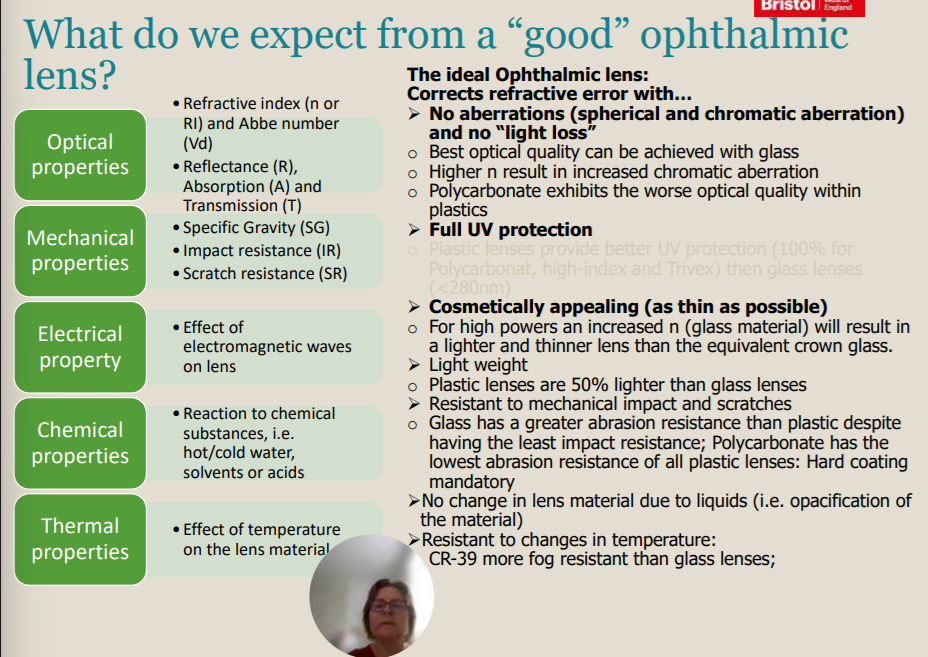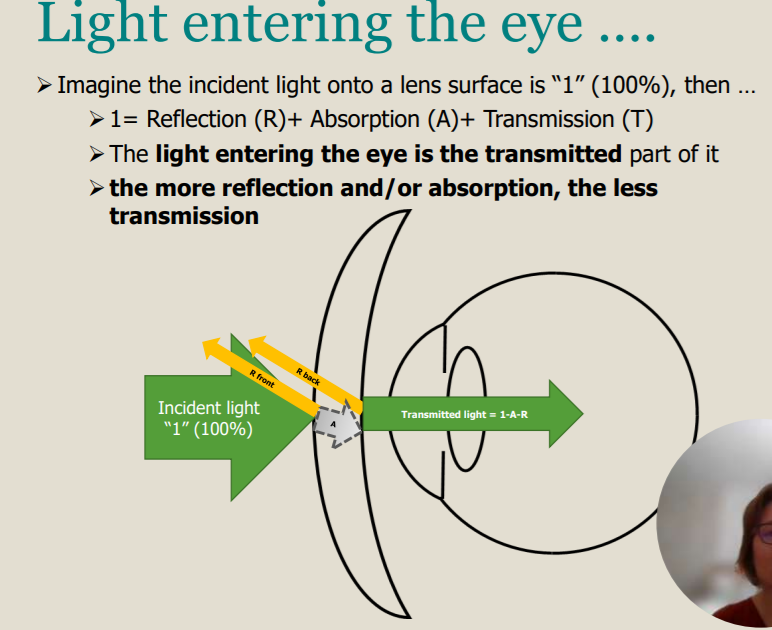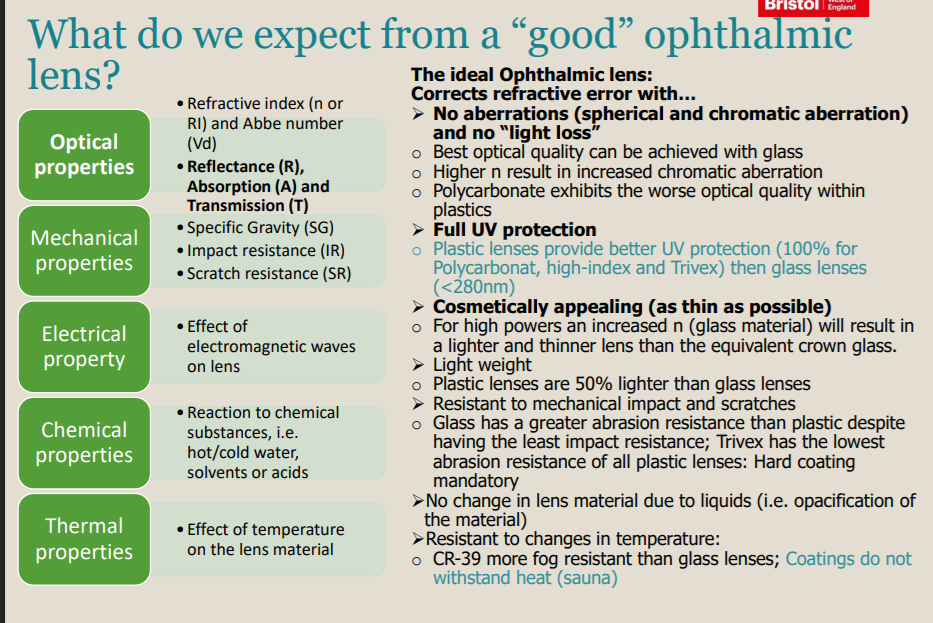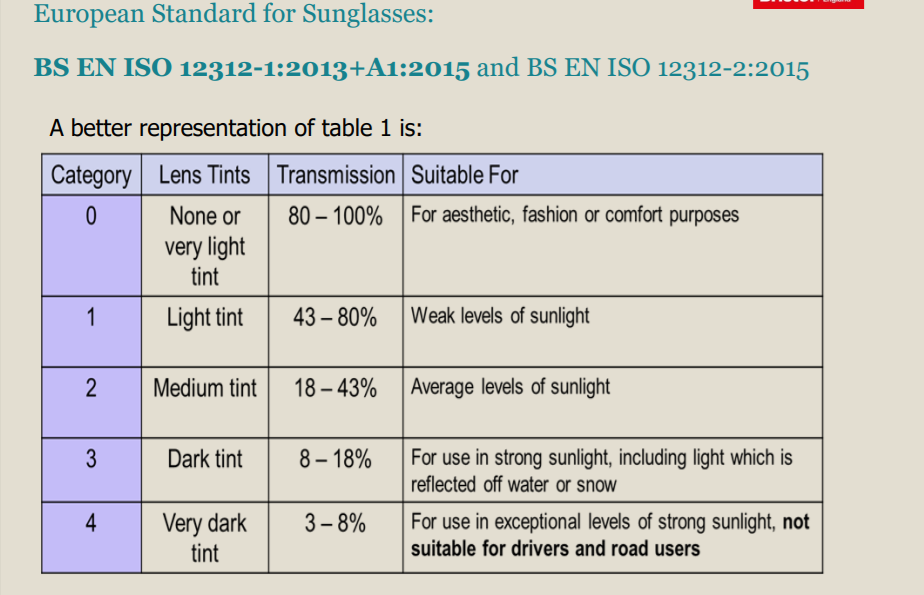Tints and Coatings
1/23
Earn XP
Description and Tags
In this session you will learn about tints and coatings that are 'attached' to lenses for various purposes such as reducing glare or protect from potentially damaging light such as UV or IR.
Name | Mastery | Learn | Test | Matching | Spaced |
|---|
No study sessions yet.
24 Terms

The ideal ophthalmic lens corrects refractive error with full __________.
UV protectio

Light Entering the Eye
Imagine the incident light onto a lens surface is “1” (100%), then …
1= Reflection (R)+ Absorption (A)+ Transmission (T)
The light entering the eye is the transmitted part of it
the more reflection and/or absorption, the less transmission
Reflectivity: 𝑅 = 100% ∗ (𝑛′−𝑛)2 / (𝑛′+𝑛)2 with n’ = refractive index material behind reflection surface and n = refractive index of material in front of reflection surface
Reflections increase as refractive index, n increases
Can be reduced by applying antireflective (AR) coating ➢Transmission:𝑇λ = 1 / log-1 𝐷λ
Transmission can be specified by density (Dλ ) per mm from a given density: Dλ = log 1/ T
Transmission will be altered in applying/using tints
Light entering the eye is the transmitted part and the increase in refractive index increases the reflections. True or False?
True
The Problem - Reflections
Lens reflections at the surfaces reduce the optical performance by creating glare, reducing light transmission and contrast
Light incident on back or front surfaces of the lens from other light sources can reduce the contrast on the screen and impair visual performance.
Light reflection off the back surface of a pair of sunglasses can create a veiling glare which reduces visual performance by reducing contrast. If the reflected light source is bright enough, it can cause discomfort.
Lens reflections at the surfaces reduce the optical performance
By producing ghost images from light sources (in front and behind the lens)
Lens reflections reduce cosmetic appearance of spectacles
Bifocals produce unwanted reflections off the segment boundary which are greatest where the thickness is widest
Concave lenses with large edge thickness produce “power rings” giving poorer cosmetic appearance
Lens reflections at the surfaces _______ the optical performance.
Reduce
Reflectance vs Refractive Index - Light Loss
Examples of light loss due to reflections on the two surfaces of a lens: The exact equation is
𝑅 = 100% ∗ (𝑛′−𝑛)2 / (𝑛′+𝑛)2 with n’ = RI of material lens and n = refractive index in air
For plastic, n = 1.49 R = 0.039 = 3.9% reflected at first surface > remaining light 96.1%
Total light loss (1st and 2nd surface) = 3.9% + (3.9% of 96.1%= 3.7%) = 7.6%
𝑅 = 100% ∗ (𝑛′−𝑛)2 / (𝑛′+𝑛)2
R = 100% x (1.49 -1.00)2 / (1.49 + 1.00)2
R= 0.039
R = 3.9%
100% - 3.9% = 96.1%
Total light loss = 3.9% + (3.9% of 96.1%= 3.7%) = 7.6%
For glass, n = 1.5 → 7.8% of light is lost by reflection
For glass, n = 1.6 → 10.4% of light is lost by reflection
For glass, n = 1.7 → 12.3% of light is lost by reflection
For glass, n = 1.8 → 15.7% of light is lost by reflection
For glass, n = 1.9 → 18.3% of light is lost by reflection
True or False?
True
The Principle of Interference
Terminology:
Wave-length – is a Phase (=2π =λ =360degree)
Phase difference between two waves of the same wavelength and its consequences:
Interference - superimposing waves
Constructive interference: when the phase difference is a multiple of λ: m x λ
Destructive interference: when the phase difference is a multiple of ½ λ: (m-1/2) x λ
Phase change (π or 180o ) on the reflection surface(s)
Happens for reflections at the border of an optically rarer vs a optically denser medium
Happens not for reflections at the border of an optically denser vs a optically rarer medium
A wave-length is a ______.
Phase
AR Coating - Thin Film Interference
Aim: two reflections are 180o out of phase (path difference =1/2λ) to cancel each other out (destructive interference), when
Thickness of the coating is ¼ λ
nAR=√𝒏𝑳ens (total cancellation)
Since there is no net reflected light energy the lens transmission increases
for n = 1.5 the coating must have a refractive index of 1.22, n = 1.7 (1.30), n = 1.9 (1.38)
MgF2 (n = 1.38) is commonly used on glass
Limitation: With a single layer, only one wavelength can be eliminated: 550nm is mostly chosen (photoscopic sensitivity of the eye)
With a single layer only one __________ can be eliminated at 550nm.
Wavelengtth
Absorbance
Occurs according to the Lambert’s law (the absorbance of a substance is directly proportional to the path length of the light beam and the concentration of the absorbing substance) and varies exponentially as a function of thickness
It is negligible in a “white” lens, but constitutes an intrinsic function in tinted and photochromic lenses and filters – lens manufacturer talk about “light reduction”
Absorbance (A) is a measure of how much light of a specific wavelength is absorbed by a sample, it follows _________ and varies exponentially as a function of _________.
Lambert's law; Thickness
Transmission
Represents the amount of light that passes through e.g. a lens
Remember the electromagnetic spectrum
Ultraviolet C: 200nm to 280 nm (absorbed by the atmosphere)
Ultraviolet B: 280 nm to 315 nm
Ultraviolet A: 315 nm to 400 nm
Visible light: 380 nm to 780 nm
Infrared: > 780 nm
Ocular transmission:
Cornea: 290 nm to 3000 nm
Aqueous Humour: 290 nm to 2700 nm
Crystalline Lens: 310 nm (young), 375 nm (old) to 2500 nm
Vitreous Humour: 290 nm to 1600 nm
UVA and UVB: damage to cornea, implicated in cataract and AMD
IR (>1400 nm): hazardous => glass blowers cataract
Considerations for occupational requirements:
UV: dentists,
IR: furnace workers
UV and IR Blocking filters available
IR is a major design feature in tinted car windows
_____ is the amount of light that passes through the lens.
Transmission
UV and IR Blocking Filters
UV-protection:
UV blocking filters can be incorporated into spectacle lenses
Should block wavelengths at least below 360 nm (ideally below 380 nm)
Coated lenses usually have a very pale brown/ yellow appearance
CR 39 does not block UV unless UV coating is applied
Polycarbonate blocks UV
IR (infrared) blocking filters are usually supplied as plano goggles / face shields
Best protection from IR - absorbing glass (addition of ferrous oxide) – usually pale green appearance
UV protection filters should block wavelengths below ______.
360nm (Ideally 380nm)
Polarisation Lenses
Light reflecting off surfaces such as water, road surfaces, car windscreens and snow becomes plane polarised (horizontally polarised).
The intensity of the reflected polarised light acts as a glare source which can be both uncomfortable and impair vision.
A polarising filter will reduce the effect of this glare:
A sheet of polyvinyl alcohol is stretched into a thin sheet
The molecules are straightened into chains lying parallel to the direction of stretch
Impregnated with iodine (electron donor) → polarising filter
Polarising sheet sandwiched between two sheets of cellulose acetyl butyrate and pressed to impart a -6 D base curve
Method: Polarization by transmission
The intensity of the reflected polarised light acts as a glare source. True or False?
True
Polarization by Transmission
Light is a transverse electromagnetic wave
Light is a transverse vibration: meaning vibrations in all directions within the same beam of light
Naturally occurring light is said to be unpolarised, i.e., vibrates in all directions
Polarisation is the process of transforming unpolarised light into a polarised state
When light is polarised, the waves in which the vibrations occur are in a single plane.
By transmission:
The stretched hydrocarbon chains can be thought of like “wires”.
The wave oscillation sets up an oscillation in the electrons within the “wires” which absorb the wave energy in the direction of the “wire” (in the case of the diagram, vertically)
The chain molecules are spaced at a distance comparable to the wavelength of light.
Light is a ________ electromagnetic wave and is said to be unpolarised.
Transverse
Tints
Purpose:
Eye protection from harmful radiation
Glare reduction
Cosmetic
Psychological
Specified by:
Colour
Transmission/absorption
Type:
Fixed,
graduated,
Rainbow,
Polarising,
Mirror,
Photochromic
There are various tint options. True or False?
True
Manufacturing Tints - Glass
Solid: tint material is incorporated within the lens matrix
Disadvantage (higher prescriptions): variable tint density dependent on lens thickness (raccooning- high minus lenses or bulls eye effect- high plus lenses)
Produced by mixing metallic oxides into glass (e.g. iron=green, nickel=brown, silver=yellow)
Advantage: repeatable
Equitint:
Tint material is vacuum coated onto the top surface of the lens or alternatively a layer of tinted glass is bonded (laminated) onto the top surface of the lens
Advantage: uniform tint density across the lens surface,
Disadvantage: not repeatable
Iron = green tint, Nickel = brown tint and silver = yellow tint. True or False?
True
Manufacturing Tints - Plastic
Most are produced by dipping the lens into a bath of hot dye (lens absorbs tint into surface layers, longer the time in the bath, the darker the tint becomes.
Tint can be lightened using a bleaching agent
Usually done manually by female workers
Note:
Equitint (most cases)
Not reproducible as tinting usually carried out by visual matching
High index plastics variable ability to be tinted
Some hard coats prevent tinting (Vacuum deposition, In mould coating)
Tints for plastic lenses are produced by dipping the lens into a bath of _______.
Hot Dye
Photochromic Glass Lenses
AgCl (Silver halides) and Cu(I)Cl (copper chloride) added to glass during manufacture (“in mass” technology)
Trace amounts of gold and palladium are added to shift the colour from grey to brown
Photochromic forward chemical reaction:
When exposed to UV light, silver ions (Ag+) are reduced to form silver atoms and
chloride (Cl-) ions are oxidised to chlorine atoms (gas trapped within the glass).
The silver darkens the lens.
Photochromic backward chemical reaction:
The reverse chemical reaction is only possible because of the addition of copper(I)chloride (CuCl).
When UV light is withdrawn, chlorine (Cl) oxidises the copper I chloride (CuCl) to copper II (Cu++) ions which then oxidise silver atoms into silver ions (Ag+).
The chloride ions (Cl-) resulting from the first chemical reaction then react with copper I ions (Cu+) and silver ions (Ag+) to form copper I chloride (CuCl) and silver halide (AgCl).
The reverse chemical reaction is much slower than the forward reaction. Hence, photochromic lenses darken quickly (approx 1 min) but lighten much more slowly (approx 40 mins)
Photochromic lenses darken quickly and but lighten much more slowly. True or False?
True
Photochromic Plastic Lenses
Also known as “Transitions” despite this being a brand-name created by Essilor.
Process is called imbibing (“surface technology”)
organic photochromic molecule from organic molecule that rotates to form a shape, reducing light transmission (e.g., naphthopyrans and spirooxazines).
A combination of several different spirooxazines, each with different light transmission and temperature dependencies is combined to give a particular brand and colour of plastic photochromic lens
Making plastic lenses photochromic is fone through a process called _______
Imbibing
Need to Know:
Reflections on lenses reduce optical performance (e.g., veil glare)
Higher n > more reflection > need for anti reflective coating (AR)
Principle of AR is thin-film interference – more layers needed to mitigate reflection caused by multiple wavelength
Transmission and absorbance are the measures to describe tints
Light that is absorbed by various parts of the eye (i.e., cornea, lens) can cause damage to the part
Advise patients on UV protection – UV coating unless polycarbonate lens
Polarised lenses help to mitigate glare from water surfaces
Tinted plastic lenses are produced by dipping - careful with high index lenses and hard coatings
Photochromic plastic lenses are produced by a process called imbibing, organic photochromic molecules (e.g., spirooxazines) change shape to adjust light transmission
Polarised lenses help to mitigate glare from water surfaces. True or False?
True

What Do We Expect From a ‘Good’ Ophthalmic Lens
Read the slide
Plastic lenses provided better UV protection than glass lenses (< 280nm). True or False?
True
Minimizing Reflections - AR Coating (Single Layer)
Utilises the principle of thin-layer interference
Reflective colour (residual hue) is determined by varying the coating thickness so that it is ¼ λ for a given wavelength
Gold AR often recommended for night driving due to shift in spectral sensitivity (scotopic sensitivity curve has a peak at 500 nm)
This layer is a thin film – not a solid layer
Does not react in the same way as the lens material to temperature changes (heat) – using the lens in a sauna can destroy the AR coating
Applied onto the lenses by: vacuum deposition technology
Metal oxides (e.g. SiO2, TiO2) are evaporated onto the lens using an electron gun; Before coating, an ion gun bombards the lens with argon ions which make the lens ultra clean (otherwise the coating may not adhere to the lens and peel off)
Single layer AR utilizes the principle of _________.
Thin-layer Interference
Multi-Layer Anti-Reflection Coatings (MAR)
Are able to eliminate reflections of more than one wavelength
Most MAR coatings have a green, blue or gold residual hue
The dimmer the hue the better the coating performance
Advantages:
Improved visual performance:– veiling glare reduction and contrast increased (night driving, VDU workers)
Improved cosmetic appearance (particularly high lens powers)
Mandatory for high index materials (too much light loss without)
Improve photochromic performance (due to increased UV transmission)
Disadvantages:
Difficult to clean: smear easily (hydrophobic coating)
Vacuum coated (expensive to manufacture)
Very thin so can easily be scratched off (combined hard MAR)
Prone to chemical damage (e.g. hairspray) and damage due to heat
MAR are achieved by vacuum coating
MAR coatings are able to eliminate reflections of more than one wavelength. True or False?
True
Mirror Coating
Mirror coatings (“silvered”) utilize the same principle as AR-coatings, but aim for “constructive interference”:
Same material as anti-reflection coating but the optical thickness of the coating is ½ λ so that the reflected light rays double the reflection
Mirror Coatings utilize the same principle as ________ coatings but aim for _____ interference.
AR; Constructive
Other Coatings
Hard Coating:
Increase the surface hardness of plastic improving scratch resistance (i.e. not scratch proof)
Between 5-10 x10-3 mm thick (10 - 20 times thicker than MAR)
Materials used for coating: diamond-like carbon (DLC) and polycrystalline diamond
Lacquer hard coats: (dip or spin) generally tintable (common way)
Vacuum deposited: (thinner but harder material e.g. silica) not tintable (often only front surface), high cost but can be combined with MAR process
In mould hard coating: material embedded within lens matrix- not tintable
Top Coating/Hydrophobic coatings (plastic lenses only)
Smearing happens on all lenses but is particularly visible in the presence of an AR coating because where the smear exists the MAR cannot function by interference (patients often complain they cannot keep the lenses clean)
hydrophobic (water repellent) properties (e.g. SiO2, Titanium oxide, perfluoropolyether)
and oleophobic (fat repellent) properties (e.g. fluoroacrylic copolymer)
Ordering coated lenses with combined hard coating, MAR and top coat will increase patient compliance and satisfaction with the coating
Hard coating make lenses _______ not scratch proof.
Scratch Resistant

European Standard for Sunglasses:
BS EN ISO 12312-1: 2013+A1: 2015 and BS EN ISO 12312-2:2015
A better representation of table 1:
(see image)
Transmission of 3-8% in category four is a ________ and is suitable for strong sunlight but not for drivers and road users.
Very Dark Tint
Photochromic Performance and Its Implications
Activation speed is much faster than fade back speed
Temperature dependent (darker and faster when cold)
Enhanced by MAR (increases UV transmission)
Not recommended for driving (reaction speed, possibly no reaction at all due to windscreen absorbing most of the UV light) … but since 2019 Transitions “XACTIVE” and “DRIVEWEAR”
UV blocking (depends on brand)
In mass (glass): tint depth proportional to thickness i.e. darker when thicker and uneven tint depth
Imbibing technique (plastic): equitint
Photochromic reactions is darker and faster when it is cold. True or False?
True